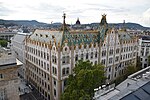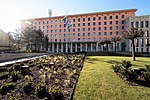Batthyány's sanctuary lamp

Batthyány's sanctuary lamp (Hungarian: Batthyány Lajos-örökmécses) is a national monument, located at the corner of Báthory Street and Hold Street in Lipótváros, Budapest, Hungary. It sits on the former location of the courtyard of the New Building, where Count Lajos Batthyány (1807–1849), the first Prime Minister of Hungary, was executed on 6th October 1849. In 1905, architect Móric Pogány's design, a large lantern, was chosen, though construction was delayed by the First World War. The unveiling ceremony occurred on 6th October 1926, with István Lebó, the last living army PFC who served during the Hungarian Revolution of 1848, present.This monument has been the site of several street demonstrations of opposition in 1941, 1943 and 1988.
Excerpt from the Wikipedia article Batthyány's sanctuary lamp (License: CC BY-SA 3.0, Authors, Images).Batthyány's sanctuary lamp
Báthory utca, Budapest Lipótváros
Geographical coordinates (GPS) Address External links Nearby Places Show on map
Geographical coordinates (GPS)
| Latitude | Longitude |
|---|---|
| N 47.50601 ° | E 19.05196 ° |
Address
Batthyány-örökmécses
Báthory utca
1054 Budapest, Lipótváros
Hungary
Open on Google Maps









